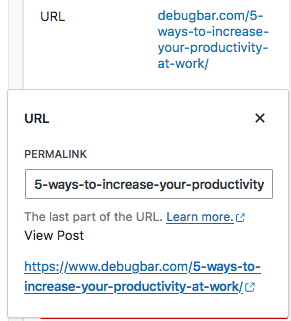How to improve seo? Our 14 pro tips
Want to boost the visibility of your website? Wondering why some sites appear on the first page of search results, and not yours? Then you are in the right place!
Given the staggering number of websites worldwide, having an online site is not enough to stand out.
To have a chance of appearing in the top search results on Google, it is imperative to work on the SEO (Search Engine Optimization) of your site.
So yes, when put like that, it might not really resonate with you. But no panic, Debugbar is here to enlighten you.
Let’s dive in! Embark with us on this journey to learn how to propel your site to the top of search engines.
What is SEO anyway?
SEO or Search Engine Optimization is a set of techniques aimed at improving the visibility of a website on search engines, and of course especially Google.
SEO works on various levers that can be separated into two main categories:
- On-Page : it focuses on your site and its content (URL, internal links, title…).
- and Off-Page : it targets external factors like backlinks.
Why would you want to improve your SEO?
Do you need a reason? Optimizing your SEO has a multitude of benefits:
- Enhances online visibility: A well-optimized site is more likely to appear in the top search results, boosting its visibility.
- Drives organic traffic: When you’re visible in search engine results, you’re more likely to attract click-throughs, thereby driving organic traffic to your site.
- Improves user experience (UX): SEO isn’t just about pleasing search engines. It involves providing quality content and a smooth UX, which in turn keeps visitors on your site longer.
- Aids branding: Properly optimized sites show up consistently across search results, helping businesses establish and reinforce their brand presence.
So, now that you’re fully convinced that SEO is essential, let’s see how to improve it !

14 Pro Tips to Improve Your SEO
Let’s put on your helmets; it’s time for some heavy lifting. Here are some expert tips that will set your SEO journey in motion:
- Perform keyword research.
- Optimize On-Page SEO elements.
- Improve content quality.
- Optimize for mobile.
- Enhance UX.
- Build high-quality backlinks.
- Think about local SEO.
- Use Schema Markup.
- Look after your core web vitals.
- Leverage social media.
- Use Google Analytics and Search Console.
- Perform regular SEO audits.
- Consider user intent.
- Don’t neglect voice search.
But let’s see that in more detail.
Tip 1: Perform keyword research
Keyword research is the backbone of successful SEO. It involves identifying words and phrases your target audience uses when looking for products, services, or content related to your business.
Here’s how you can do it:
- Use keyword research tools: Tools like Google Keyword Planner, Ahrefs, or SEMRush can help you find relevant, high-volume keywords. Remember, the goal isn’t only to find popular keywords but also ones that are as relevant as possible to your content.
- Naturally incorporate keywords: Once you have your set of keywords, the next step is to incorporate them naturally into your text content, meta tags, URLs, and alt attributes.
But remember – keyword stuffing is a big no-no and can get you penalized by search engines.
Tip 2: Optimize on-page SEO elements
On-page SEO refers to all the measures that can be taken within your website to improve its position in search rankings.
It’s not just about content, but also about the underlying HTML code.
Here’s how you can improve your on-page SEO:
- Title tags: Your meta title should include the target keyword and be within 50-60 characters to ensure it displays properly in search results.

- Meta descriptions: Think of these as small ad copies that sell your content. Write compelling meta descriptions up to 160 characters long using target keywords.

- Headers: Header tags (H1, H2, H3) are used to structure your content and should incorporate keywords where appropriate.

- URL Structure: URL is another crucial aspect of on-page SEO. Use SEO-friendly URLs that are short, descriptive, and include keywords.

Tip 3: Enhance content quality
Content is king, as the adage goes. Not only does high-quality content impact your SEO ranking, but it also helps to engage and retain visitors. Here’s how you can up your content game:
- Be engaging and relevant: Your content should always provide value to your audience. This means writing on topics they care about and providing meaningful insights.
- Vary content types: Don’t become monotonous with just text content. Mix it up with images, videos, infographics; diversification can attract a wider audience.
- Think about readability: Make your content user-friendly by using short paragraphs, bullet points, and subheadings. This will help users skim through your content easily.
Keep in mind that Google and other search engines prioritize quality over quantity, so always strive to provide the best possible content for your audience.
Tip 4: Optimize for mobile
In an era where smartphones rule, optimizing your website for mobile devices is non-negotiable.
In fact, Google uses mobile-first indexing, meaning it predominantly uses the mobile version of a site for indexing and ranking.
Here are some ways to make your website mobile-friendly:
- Adopt a responsive design: A responsive website adjusts its layout based on the device it’s being viewed on. This ensures that your site looks great and performs well on all devices.
- Optimize for speed: Time is precious, and nobody likes waiting for slow-loading pages. Compress images, leverage browser caching, and minimize HTTP requests to boost your page speed.
- Test: Regularly test your site on various devices to ensure an optimal user experience. Tools like Google’s Mobile-Friendly Test can help check the mobile usability of your site.

Tip 5: Enhance user experience (UX)
Having a website that looks pretty is great. But if your visitors struggle to find what they’re looking for or have to wait ages for pages to load, they won’t stick around long.
User experience is all about how users interact with your site. A positive UX can result in users spending more time on your site, boosting your search rankings.
Here are some ways to enhance the UX:
- Improve site navigation: Your site should be easy to navigate. A clear and logical structure can guide users to the information they are looking for, reducing bounce rates.
- Speed it up: As mentioned earlier, slow-loading pages can drive users away so work on reducing page load times and optimizing page speed.
- Minimize pop-ups: Pop-ups can be disruptive and annoying. If you must use them, make sure they’re easy to close and don’t negatively impact the user’s experience.
Remember, user experience isn’t just about aesthetics; it’s about how well your site serves its users.
Tip 6: Build high-quality backlinks
Backlinks – links from other websites to yours – are highly valued by search engines. They see those links as votes of confidence, meaning they can significantly boost your site’s ranking.
But not all backlinks are created equal.
Here’s how to build high-quality ones:
- Earn backlinks: The best way to get those precious links is to create excellent content that others naturally want to link to. This can include blog posts, infographics, videos, or any other type of valuable content.
- Avoid spammy tactics: Buying links or partaking in link schemes can lead to penalties from search engines. It’s best to stick to earning links organically.
- Reach out: Consider reaching out to bloggers or businesses in your industry and ask them to consider your content or business and make a link in their next article.
Tip 7: Optimize for local SEO
If you’re a local business, optimizing for local SEO is crucial. This means setting up your website and online presence to target people in your specific geographic area.
Here’s how to get started:
- Google My Business: Claim and optimize your Google My Business listing. This will help you appear in local search results and Google Maps.
- Use local keywords: Incorporate keywords that are specific to your location into your site content and metadata.
- Build local citations: Getting listed on local directories and receiving reviews can boost your local search visibility.

Tip 8: Use Schema Markup
Schema markup is a form of microdata that helps search engines better understand your content.
When you add schema to your website, it creates an enhanced description (commonly referred to as a rich snippet), which appears in search results.
Here’s how:
- Choose the right schema: There are various types of schema you can use depending on your content. Some common ones include Article, Product, Event, etc.
- Add the schema to your site: Once you’ve chosen the appropriate schema, you can use a tool like Google’s Structured Data Markup Helper to generate the necessary code, which can then be added to your site.
Tip 9: Optimize for core web vitals
Core Web Vitals are a set of metrics Google uses to measure a website’s overall user experience.
They focus on three aspects: Loading (Largest Contentful Paint or LCP), Interactivity (First Input Delay or FID), and Visual Stability (Cumulative Layout Shift or CLS).
- LCP: This measures the loading speed of the content that’s most important to the user experience, like images or videos. To have a good LCP loading, ensure your server is fast and your images are properly sized.
- FID: FID measures the time it takes for a user to first interact with your site after it begins loading. To improve FID, minimize Javascript and make sure your pages respond quickly to user interactions.
- CLS: This gauges how much your page layout shifts as it loads. For optimal CLS, ensure all elements on your page have a set width and height.
Tip 10: Leverage social media
Social media platforms provide a fantastic opportunity to reach a larger audience and drive traffic to your site, enhancing your SEO efforts.
Here are some ways you can leverage social media for SEO:
- Promote your content: Whenever you have a new post or update on your site, share it on your social media platforms. This will help drive traffic from your social pages to your site.
- Encourage social sharing: Add share buttons to your blog posts and encourage your readers to share your content on their social profiles. This can help increase your content’s reach and possibly attract new followers.

Tip 11: Use Google Analytics and Search Console
Keeping track of your SEO efforts is pivotal. Fortunately, Google provides two invaluable tools for this: Google Analytics and Google Search Console.
- Google Analytics: This tool allows you to monitor your site’s traffic, user behavior, and conversion rates. You can use this data to identify areas on your site that need improvement.
- Google Search Console: This tool helps you understand how Google views your site. You can use it to submit sitemaps, fix crawl errors, and view the search queries that led users to your site.
Tip 12: Regularly audit your SEO
Regular SEO audits are essential to ensure your site remains optimized and any potential issues are quickly identified.
Here’s what you should focus on:
- Broken links: A broken link can harm your site’s user experience and your search ranking. Tools like Broken Link Checker will automatically identify any broken links for you.
- Duplicate content: Search engines penalize sites with duplicate content. Use tools like Siteliner or Copyscape to check for any replicated content across your site.
- Site speed: If your site takes too long to load, people will leave, and your bounce rate will increase, affecting your ranking. Regularly check and enhance your site’s loading speed.
Tip 13: Consider user intent
Aligning your content with user intent means understanding what your target audience is looking for and providing it.
This can be:
- informational (looking for information),
- transactional (looking to buy something),
- or navigational (looking for a specific site).
Tip 14: Think about voice search
With the growing use of digital assistants like Alexa, Siri, and Google Assistant, optimizing for voice search is more important than ever.
Here’s how:
- Use conversational keywords: Voice searches are typically longer and more conversational. Incorporate long-tail keywords that mimic how people talk and ask questions in real life.
- Optimize for featured snippets: Google often uses featured snippets for voice search results. Structure your content to answer questions concisely and format it in a way that makes it easy for Google to pull into a snippet.
Remember, SEO is not a one-time thing; it requires ongoing effort and adaptation to changing algorithm patterns. So keep learning, testing, and evolving.
Improving your SEO: Wrapping it up
In a nutshell, improving SEO involves multiple activities – from comprehensive keyword research to creating high-quality content, enhancing the user experience to building quality backlinks, and more.
- Understand your audience and their search intent.
- Create and optimize high-quality content around targeted keywords.
- Improve website speed and mobile optimization.
- Regularly monitor your site’s performance using analytic tools.
While these tasks can be time-consuming and sometimes complex, their benefits are immense.
By investing time in SEO, you’re setting your website up for better visibility, increased organic traffic, and ultimately more conversions.